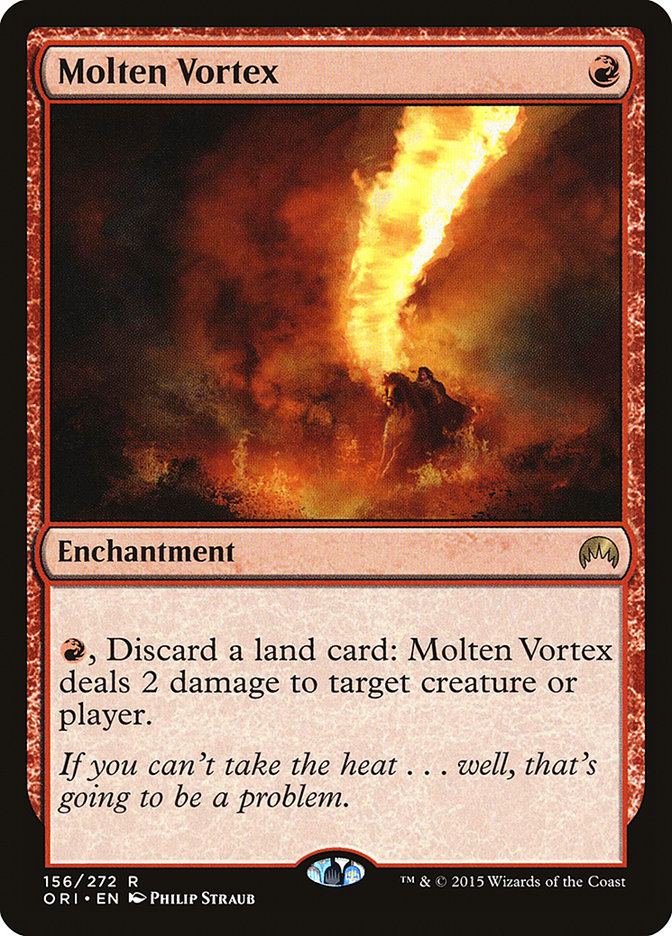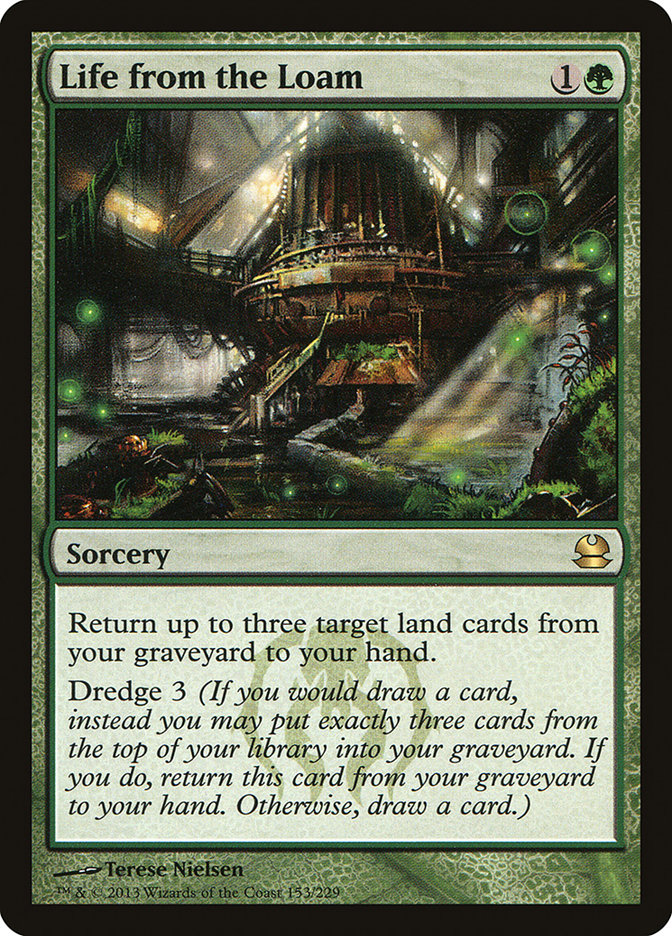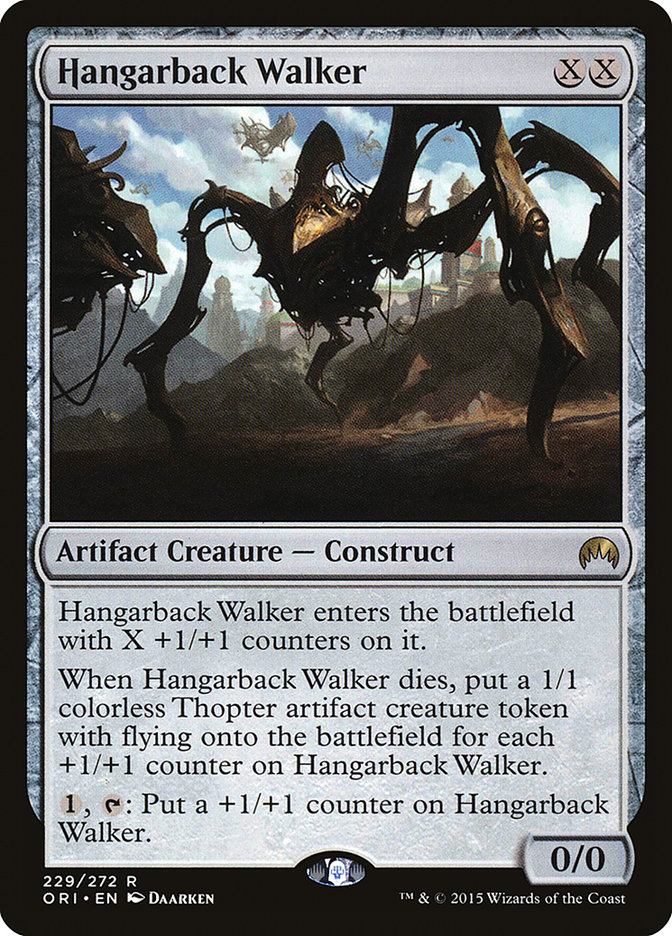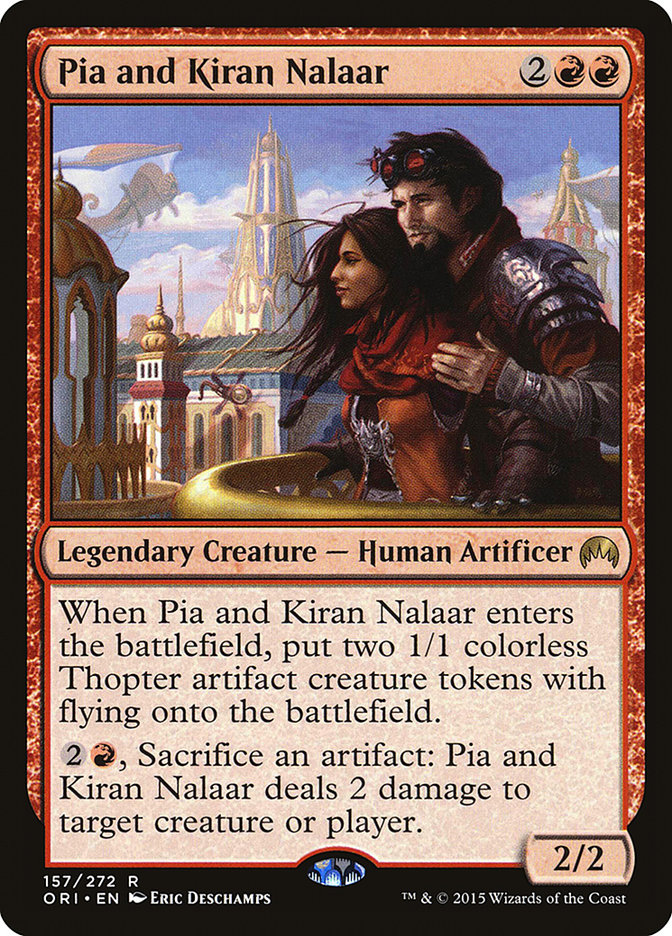My testing process has either been refined or bastardized and I’m not sure which.
Grand Prix Oklahoma City was fast approaching and, as usual, I wasn’t happy with any of the Modern decks. Modern has typically been a format where I’ve
underperformed, especially considering how well I used to do in Extended. As it turns out, I do better when I have broken cards in my decks and not a lot
of those exist in Modern.
I don’t have an issue with Modern as a whole, but there isn’t a deck that speaks to me. There isn’t something I could play for the rest of my life and
never get sick of. There are some people who have that, and I am incredibly envious. I can’t imagine what it would be like to have a Modern tournament
approaching and have to do zero homework. Simply dust off your deck box and you’re ready to win another Grand Prix with Birthing Pod!
U/W Tron was my weapon of choice for a while, but there were a number of issues. For starters, Modern was young and constantly being shaken up by bans and
unbans so that people couldn’t keep track of what was going on. Each time there was a tournament, the focus was always on the perceived threat. No one ever
bothered to worry about U/W Tron, and for good reason.
As time went on, U/W Tron didn’t get any new toys while all the other decks were being built better. The format seemed to speed up, while U/W Tron was
relying on Remand and Azorius Signet to keep them on top of things, but those only really helped on the play. On the draw, the deck struggled to stay with
it. U/W Tron, it seemed, was officially dead.
Jund was good to me for a bit, but that time has since passed. The combo decks that exist now are actually pretty good against Jund, and even Grixis was
good against it thanks to some new releases. Brad may still enjoy being Jund Guy, but I do not.
So, where did that leave me?
From looking at the format, it didn’t seem like any deck could really beat that combination. Originally, I thought Molten Vortex would be a worse Seismic
Assault, and I was basically right. However, I didn’t consider what would happen when you played all eight Vortexes and Assaults — Your deck is actually
somewhat consistent!
I built it and played online some, but finding Life from the Loam proved to be problematic. It did appear that no one could beat repeatable Shocks, which
makes sense since Punishing Fire is banned for a reason. The format had circled around to a place where Seismic Assault was game over against nearly
everything. I had Flashback of Griselshoalbrand, going twenty or more cards deeper into my deck and never finding my lynchpin.
I was off it.
As I was pondering canceling my flight to Oklahoma City, Todd Anderson was crushing the Open Series in Cincinnati with Infect. I fired up Magic Online and
won my first two 8-player queues with it. After a few more matches and the run-goods wore off, the holes started becoming more and more apparent.
In the middle of all this, I was working with Patrick Chapin on the Temur Prowess deck he ended up playing in the Grand Prix. The deck was good, but it
felt weak to anyone trying to go over the top of you, grinding you out, or going wide around you. However, that was also how I felt about U/W Delver when
it was Standard legal. Sure, the deck has these tiny weaknesses, but in reality, those gameplans almost never come to fruition because you find some way to
kill them first. Perhaps I gave up on the deck too early. Make no mistake, Abbot of Keral Keep is very good in Modern, and Mishra’s Bauble is likely the
card that puts it over the top.
Since Brad was being all Jund Guy, I was kind of forced to be working on the archetype as well. We kept coming back to the deck we played in Grand Prix
Charlotte though. I had a rough sketch in my head for a Jund Aggro deck that was built around the shell that Patrick Chapin developed, but I knew that Brad
wouldn’t be interested, so I ignored it for the time being. Plus, I had other stuff to work on, like Abzan!
A couple months ago, Lightning Bolt wasn’t very good anymore. These days, Lightning Bolt is premium, but you need more than just it to stand up to
Affinity, Merfolk, and Infect. You could bastardize your Jund deck to only beat creature decks, but that didn’t seem like an option to me. You’d have to
ditch the discard and Liliana of the Veil aspect, but you’d be soft against the combo decks in the format.
Abzan Aggro was a possibility. Mana accelerator into Knight of the Reliquary felt like a good way to beat the big mana decks like G/R Tron and Amulet
Bloom, but I felt like those decks would be on the decline since Merfolk and Affinity aren’t easy matchups. While testing for Grand Prix Vancouver, I was
working on the Abzan Aggro deck that was popular at the time and ended up hating it. BBD was pushing for it pretty hard in our team forum but ended up
changing decks at the last second. It looks like we both made the right decision.
Then Michael Majors showed me a deck that I thought may have broken Modern.
Creatures (14)
Lands (22)
Spells (24)
- 3 Goryo's Vengeance
- 4 Lightning Bolt
- 4 Serum Visions
- 2 Remand
- 4 Inquisition of Kozilek
- 3 Thought Scour
- 2 Murderous Cut
- 2 Kolaghan's Command
Sideboard

What if your combo to go along with your Deceiver Exarch was Snapcaster Mage or Jace, Telepath Unbound? Surely having your combo pieces be great in other
spots was a good place to be, right?
This deck required a ton of work and we didn’t have a lot of time. How many combo pieces did we want? Could it be combo-control or did it have to be all-in
on the combo? What does a manabase for a low land count deck that occasionally wants to be casting Kiki-Jiki, Mirror Breaker look like?
At the time, I had work to do, so I wasn’t able to get in any reps with the deck. By the time I was free, everyone had played with the deck and done
poorly, but no one had tried to fix it. It didn’t look like the time to try it, but I’ll definitely be working on it in my spare time.
After that bubble burst, there was a solid day where I thought I was going to play Living End at the Grand Prix. I made several strides with the archetype
that I was pleased with, but playing the actual games made me frustrated. Hate was easy enough to shrug off and the deck “got it in good” almost every
game, but you were never a lock to win. Even by assembling your “combo,” you didn’t guarantee victory. Unsure if I could go through an entire tournament
like that, I put it away, but kept it in my back pocket.
Then Trinket Mage for Hangarback Walker made an appearance.
Trinket Mage and I are friends. We really are. We go way back. But he’s the type of dude that promises so much and gives so little. Card advantage! A
toolbox! Virtual copies of hate cards! A win condition! With Hangarback Walker, it’s all there, right?
Here’s the thing — I strongly dislike the backdoor tutoring mentality in Magic. There exists a common belief that if Hangarback Walker is playable, you
should only play Hangarback Walker if you’re also casting Trinket Mage for it. Why play a bunch when you can have one whenever you need it, right? As it
turns out, a turn 4 Hangarback Walker that cost you five mana isn’t nearly as good as the two mana copy you could have played on turn 2. It may seem easy
to just tutor up whatever you need, whenever you need it, but you don’t always have that luxury.
Lately, people have been sending me the Gifts Ungiven/Scapeshift deck that did well in the Italian WMCQs, and I feel similarly. If you want to Gifts
Ungiven into Elesh Norn, Grand Cenobite to find traditional anti-Scapeshift hate, then that’s understandable. However, if you’re trying to play less copies
of Scapeshift because you can Gifts Ungiven for Scapeshift / Snapcaster Mage / Eternal Witness, you’re doing it wrong. Modern is a fast format. Stop
messing around.
Anyway, the Trinket Mage deck didn’t appear to be what I wanted in practice, even if the deck looked great and I wished it were good. The backdoor Trinket
Mage for Basilisk Collar to put on my Grim Lavamancer or Izzet Staticaster worked about as well as you’d expect. Pia and Kiran Nalaar, as I suspected,
turned out to be a great card for Modern, so at least something came out of it. With that in mind, I started working on Grixis Control lists featuring the
card. Again, I couldn’t point to anything specific about the deck that made me want to play it, but it was a fine backup choice.
Just as Molten Vortex was good and Living End was good, Scapeshift was also very good. Modern’s metagame features a host of decks that have turn 3 or 4
virtual kills but don’t actually kill you until turn 5 or 6. That bodes well for the resilient combo deck that often doesn’t win until turn 5 but can buy
multiple turns by casting Cryptic Command.
Scapeshift was the best choice for the weekend.
I sleeved up Grixis Control.
Huh?
Well, there are lots of ways to build Scapeshift, and I wasn’t confident I would find the right one. Still, I knew that even a bad Scapeshift deck would
likely be better than a good Grixis list. For whatever reason, I decided to ignore my heart and go with the deck I could work with Michael Majors on until
3 AM Friday morning. Meanwhile, I had nobody to work with on Scapeshift.
I arrived on site Friday afternoon and built the Jund Aggro deck I sketched up on the plane. My three games of testing against Splinter Twin proved
fruitful, and I briefly considered playing the deck in the tournament. In reality, I was waiting for Michael Majors’ flight to arrive so we could get to
work on Grixis.
This is what we settled on:
Creatures (12)
- 1 Grim Lavamancer
- 3 Snapcaster Mage
- 2 Tasigur, the Golden Fang
- 4 Jace, Vryn's Prodigy
- 2 Pia and Kiran Nalaar
Lands (23)
Spells (25)
- 4 Lightning Bolt
- 1 Mana Leak
- 4 Serum Visions
- 1 Terminate
- 2 Remand
- 4 Inquisition of Kozilek
- 1 Twisted Image
- 1 Go for the Throat
- 1 Dismember
- 3 Thought Scour
- 1 Rise
- 2 Kolaghan's Command
Sideboard

Majors added two Pyroclasms to his sideboard at the last second, which he didn’t tell me about. Jerk.
I spent two weeks battling with a bunch of decks I didn’t end up playing when I knew Grixis would be a fine choice. Instead of practicing with a deck I
could learned the ins and outs of, I desperately tried to break the unbreakable format. Some might say it was a waste of time, but I was also able to
understand the format better by getting a look at the bigger picture.
But yeah, 33rd place. The bubble strikes again, although at least this time it wasn’t on tiebreakers, so I can’t exactly be mad. As for the deck itself, I
would ignore this list, because there are some things I got right, but there’s also a reasonable amount of stuff that I’d change if I could do it over
again.
Things started rocky with a Round 4 loss to teammate Steve Rubin, who played well as always. I ran it up to 7-1 where another teammate, Brian Braun-Duin,
was waiting for me. Thanks to a Molten Rain on my end, he didn’t cast many spells in Game 3, so I was able to finish the day at 8-1 and in great shape. I
suppose he got the last laugh though.
At one point, I was 11-1 and on top of the world (or at least the standings) but couldn’t close. I lost a win-and-in against the eventual champ, Zac Elsik,
who totally impressed me by playing quickly and competently. In Game 1, I made a huge error in a game I thought I was probably going to lose, basically
because I wasn’t familiar with his deck. In Game 2, it’s possible he made the same type of error because he seemed surprised that I could play Vandalblast
out of the graveyard with overload via Jace, Telepath Unbound. In Game 3, I came up a little short on every metric, as he was always able to find what he
needed.
It was one of those matches where I wish it was on camera so I could find out exactly where I made mistakes. Either way, it was a helluva match, and Zac is
a well-deserving champion.
At 11-2, I was in a spot where I could win two matches in a row to make Top 8, but I ran afoul of Asa Snyder’s Grixis deck splashing Lingering Souls. The
matchup didn’t look too bad on paper, but his deck had more action than mine overall, and it showed during the games. In the final round, I lost yet again
to Lingering Souls, bringing my total record against that card to 2-2 on the weekend.
Once again, I made a deep run but failed to close.
This is what I would play now:
Creatures (13)
- 1 Grim Lavamancer
- 1 Glen Elendra Archmage
- 3 Snapcaster Mage
- 1 Izzet Staticaster
- 2 Tasigur, the Golden Fang
- 4 Jace, Vryn's Prodigy
- 1 Pia and Kiran Nalaar
Planeswalkers (1)
Lands (23)
Spells (23)

Why, yes, I was working on Grixis Highlander while I was bored on my way to the Grand Prix. So what?
I have no idea if the sideboard allows for clean sideboarding in the popular matchups, and I know the maindeck looks super weird, but that’s basically
because I want to try some stuff before I rule it out. First of all, Lingering Souls (and decks like Steve Rubin’s) proved difficult to beat. The lack of
sweepers mattered in those matchups and, unsurprisingly, I didn’t perform well as a result.
Ideally there would be some sort of sweeper maindeck, but I hate Engineered Explosives with a passion (even though it would have been a solid sideboard
card for me in the tournament). You almost always trade down on mana usage, and it’s rare to get a two-for-one because of how spread out the casting costs
are. Electrolyze mostly does the job against Lingering Souls, as you can deal with one half rather easily, but I think I need something else. My sideboard
plan of blocking Lingering Souls tokens with Glen Elendra Archmage didn’t seem to work out too well either. While writing this, I’ve decided that I can
happily try a maindeck Izzet Staticaster.
Honestly, Damnation maindeck isn’t out of the question, but I prefer the proactive approach to problem solving in Modern. Trying to set up and then tapping
out for Damnation or Anger of the Gods does not seem to win me very many games. When the sweepers are cheap, like Pyroclasm, it’s common for me to be able
to pick up the pieces with my remaining mana, whether it’s a creature that’s too large or a creature-land waiting in the wings.
Those are all reasons I decided to call up Mom and Dad.
This card is excellent and very playable in Modern. If you’re playing Jund, I recommend trying it over Huntmaster of the Fells. Your opponent can’t
effectively deal with it by using a single card, and sometimes it immediately stabilizes you. If nothing else, you get some chump blockers which will buy
you time. If Pia and Kiran Nalaar die, you have several ways to bring them back. On top of it all, double blocking Etched Champion with Thopters is one of
the few ways to actually remove it.
If Lingering Souls was my major cause of distress, then being action-light was the other. I was often spinning my wheels looking for something noteworthy
to do, meanwhile my opponent was beating me down with a Siege Rhino or an Ornithopter with a spiky hat. Most of the time I came up with something, mostly
because Pia and Kiran Nalaar are excellent at stabilizing a board, but I could tell that I was working harder than I needed to be.
Instead of trying to solve every problem, you should see if you can try making that problem irrelevant. If your deck has difficulty killing a bunch of 1/1
fliers, perhaps you should try killing your opponent instead. If you’re worried about them blocking your stuff, play stuff that’s good in combat or go
around them somehow. Another option is to find a card that is basically the analogue to it, and Pia and Kiran Nalaar are the Grixis Lingering Souls.
Grim Lavamancer is a funny card. Sure, you can point to Affinity and Merfolk as matchups where the card will overperform, but most of the time it’s going
to be this thing that sits there and kind of annoys your opponent. That’s the thing though — You don’t necessarily need to point to a card being good at
anything specific in order for it to be good. Grim Lavamancer has an ability that doesn’t accomplish much on its own, but it makes the jobs of your other
cards much easier.
Tarmogoyf now dies to your Lightning Bolts. Cards like Liliana of the Veil are much easier to deal with. Random creature hordes are kept in check.
Opponents are easier to burn out. Sticky creatures like Voice of Resurgence and Kitchen Finks no longer give you fits.
Effectively, it makes each of your cards perform their jobs better, especially if your deck is built on efficiency instead of power. Izzet Staticaster
performs a similar, albeit narrower role. For example, you wouldn’t put Izzet Staticaster in your maindeck to beat Snapcaster Mage, but once you have Izzet
Staticaster on the battlefield, your opponent likely won’t be tempoing you out with Snapcaster Mage or similar creatures like Pestermite or Vendilion
Clique. As long as Modern is full of creature decks, I don’t mind playing with cards like those in the maindeck.
Rise//Fall is a weird one. It’s not like a Lightning Bolt or Doom Blade where what the card does to the game is clearly printed on the card. Rise can be
excellent, but sometimes it’s a poor way to control the board. Fall can be backbreaking, but sometimes they reveal a couple of lands. There are also some
unintuitive lines to take.
For example, I wanted to Fall my opponent and get their last two cards, which I suspected were both spells. That meant I had four mana left for the turn. I
determined that none of the ways to spend that four mana were better than drawing a Tasigur, the Golden Fang for free, so that’s what I decided to do. I
cast Rise targeting Tasigur in the graveyard, my Snapcaster Mage on the battlefield, cast my Snapcaster Mage giving Fall Flashback, and Fall-ed my
opponent’s last two cards.
It felt weird, but it seemed correct.
Against the Lantern Control deck, I knew that “bounce your Spellskite, Raise Dead your Spellskite, attack you with a bunch of Snapcaster Mage” was a thing
that could come up in order to get through Ensnaring Bridge. Overall, the card has a lot of uses.
It mainly served as a weird version of the third Kolaghan’s Command. In decks like these where you not only see a bunch of cards per game but your
graveyard is also a resource, having more options can be helpful. If you have a Snapcaster Mage in hand but only four Lightning Bolts in your graveyard,
your Snapcaster Mage is only going to be able to Flashback one thing — You have no choices. If your graveyard is loaded with Lightning Bolt, Murderous
Cut, Kolaghan’s Command, and Rise//Fall, you have plenty of options. Chances are, since you have more options, you’ll be able to craft a gamestate in which
you’ll end up winning.
Grixis Control, especially this version that is focused on beating decks with low mana curves thanks to narrow(ish) cards like Inquisition of Kozilek and
Lightning Bolt, you really want something to deal with more expensive spells. Sometimes you can grind through them with Snapcaster Mage and Jace, Vryn’s
Prodigy, but most of the time you’re going to fold to an army of Siege Rhinos or Primeval Titans.
The great thing about Rise//Fall is that the Hymn to Tourach mode covers you against the bigger spells of the format. You can usually defend yourself
against the first wave of threats with Mana Leak or Terminate in certain matchups. They’ll typically sandbag their best threats, not expecting the double
discard. It can also clear their hand of bad spells, especially in Game 1 when they’ll still have them in their deck. That allows draw step Kolaghan’s
Command, forcing them to discard a card, into a functional Time Walk when they’re empty handed.
Rise//Fall may be worse than Kolaghan’s Command in a vacuum, but I think it’s earned its place.
Mana Leak constantly impressed me over the weekend. Remand, while excellent in blue mirrors, was poor against nearly everything else. I tried to build the
deck so I didn’t have any cards that were terrible in specific matchups, aside from Lightning Bolt (which is basically a necessity), but perhaps I expected
too much of Remand.
I could go on for pages and pages about specific card choices and the theory behind building decks like this, but it’s late, this article is long enough
already, and I feel like I’m just scratching the surface. I’m just starting to understand what it takes to do well in Modern, so I’ll leave that for
another time.
Some of the nicest things happened to me this weekend. As I took my seat on the first leg of my flight to OKC, a kid on the way to his seat wished me good
luck at the Grand Prix. One of my opponents and I had a nice conversation about streaming and being a role model. Several people said they liked my deck.
On top of it all, I made another deep run, this time in a format where I haven’t had the best results, all while wielding an unlikely weapon. I even got to
manascrew BBD with a Molten Rain. The near miss stung and will continue to sting, but I look forward to finally closing.






